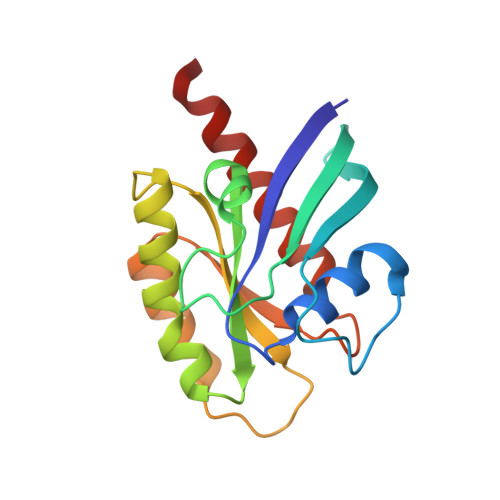Crystal structures at 2.2 A resolution of the catalytic domains of normal ras protein and an oncogenic mutant complexed with GDP.
Tong, L.A., de Vos, A.M., Milburn, M.V., Kim, S.H.(1991) J Mol Biol 217: 503-516
- PubMed: 1899707
- DOI: https://doi.org/10.1016/0022-2836(91)90753-s
- Primary Citation of Related Structures:
1Q21, 2Q21 - PubMed Abstract:
The biological functions of ras proteins are controlled by the bound guanine nucleotide GDP or GTP. The GTP-bound conformation is biologically active, and is rapidly deactivated to the GDP-bound conformation through interaction with GAP (GTPase Activating Protein). Most transforming mutants of ras proteins have drastically reduced GTP hydrolysis rates even in the presence of GAP. The crystal structures of the GDP complexes of ras proteins at 2.2 A resolution reveal the detailed interaction between the ras proteins and the GDP molecule. All the currently known transforming mutation positions are clustered around the bound guanine nucleotide molecule. The presumed "effector" region and the GAP recognition region are both highly exposed. No significant structural differences were found between the GDP complexes of normal ras protein and the oncogenic mutant with valine at position 12, except the side-chain of the valine residue. However, comparison with GTP-analog complexes of ras proteins suggests that the valine side-chain may inhibit GTP hydrolysis in two possible ways: (1) interacting directly with the gamma-phosphate and altering its orientation or the conformation of protein residues around the phosphates; and/or (2) preventing either the departure of gamma-phosphate on GTP hydrolysis or the entrance of a nucleophilic group to attack the gamma-phosphate. The structural similarity between ras protein and the bacterial elongation factor Tu suggests that their common structural motif might be conserved for other guanine nucleotide binding proteins.
Organizational Affiliation:
Department of Chemistry, University of California, Berkeley 94720.
















